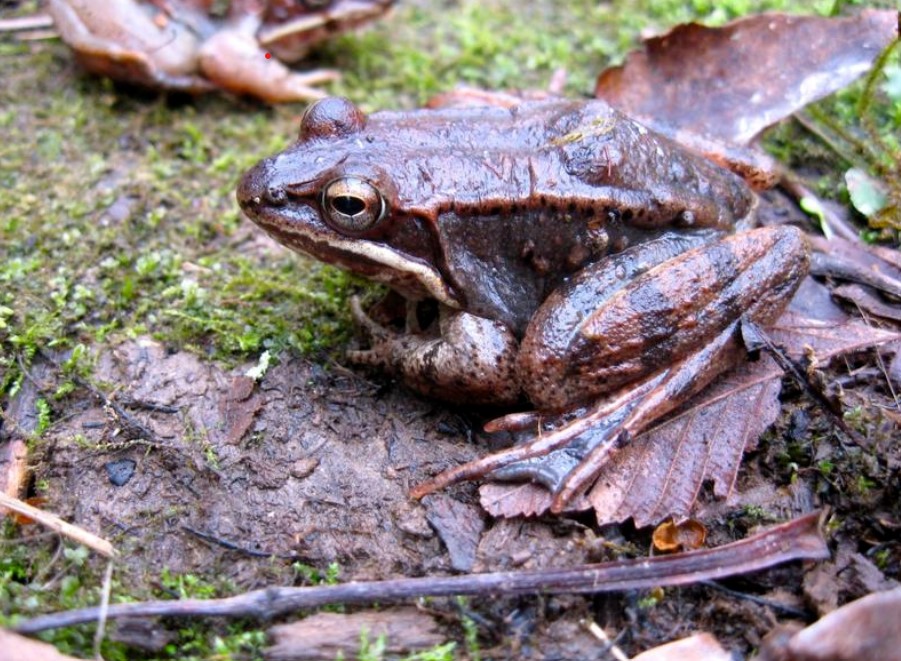Dr. Clara do Amaral's work with wood frogs is now being featured in the BBC’s “A Perfect Planet” series.

MOUNT ST. JOSEPH UNIVERSITY
FOR IMMEDIATE RELEASE
Contact:
Dr. Clara do Amaral
513-244-4733
clara.doamaral@msj.edu
CINCINNATI – After a video production crew from the British Broadcasting Company spent more than a week filming wood frogs in Dr. Clara do Amaral’s laboratory two years ago at Mount St. Joseph University, these freeze-tolerant amphibians are making their television debut on the network’s critically acclaimed nature series, “A Perfect Planet.”
Dr. do Amaral, an assistant professor of biology at the Mount, has been studying cold- tolerance physiology of North American frogs for 11 years, particularly wood frogs, which are found from the Artic environs of Alaska to more temperate climates in Ohio, Kentucky, and West Virginia.
The remarkable trait of wood frogs is that they can freeze solid during cold winter months, when their hearts actually stop beating, but come back to life during spring thaws, when their heart resumes beating, blood melts, and recirculates through veins.
“Most toads hibernate by burying themselves below the frost line and most frogs retreat to deeper water when lakes or ponds freeze during the winter months,” Dr. do Amaral said. “But wood frogs are different; they spend their winters close to the surface of the ground, where their bodies actually freeze solid.”
A videographer from the BBC’s production company, an expert in time-lapse imagery, spent 12 hours a day over the course of a week in Dr. do Amaral’s lab at the Mount filming these frogs as they were frozen and thawed. The production crew also filmed the frogs in their natural habitat at Northern Kentucky University’s Research and Education Field Station near the Ohio River in Melbourne, Ky.
“After shooting more than 100 hours of video in the lab and on location, the final segment in the television production is only about a minute and half long,” Dr. do Amaral said of “The Sun” episode, which is narrated by Sir David Attenborough, the award-wining English broadcaster and natural historian. The episode has aired on the BBC in Great Britain and is now being streamed in the United States on Discovery+.
The focus of Dr. do Amaral’s research has been on cryoprotectants found in these frogs. Cryoprotectants are substances – natural antifreeze, if you will – in amphibians, reptiles, and some insects that protect their biological tissue from freezing damage. The primary cryoprotectants employed by wood frogs during this freezing process are glucose and urea.
A native of Lisbon, Portugal, Dr. do Amaral received her bachelor’s degree in biology from the University of Lisbon, a master’s degree in biology from Western Kentucky University, and her Ph.D in zoology from Miami University. She completed a postdoctoral fellowship at the University of Dayton, then joined the faculty at Mt. St. Joseph University in 2017.
She first started studying the tolerance of cold-blooded organisms to low temperatures with Drs. Jon Costanzo and Richard Lee, her Ph.D. advisors at Miami University. Since that time, Dr. do Amaral has co-written numerous scholarly articles about these organisms with Dr. Costanzo and other colleagues.
Her doctoral work investigated how the freeze tolerance of wood frogs from Alaska differed from those in Ohio. This study found that wood frogs in northern climates are more freeze-tolerant than frogs in living in southern climates thanks to multiple physiological adaptions.
“We confirmed that Alaskan wood frogs can survive being frozen at much lower temperatures and for much longer periods than Ohio wood frogs,” Dr. do Amaral said. “At - 4ºC, Alaskan wood frogs can stay frozen for up to two months while Ohio wood frogs can tolerate this temperature for only two to three weeks.”
Her study found that Alaskan wood frogs accumulate more cryoprotectants, which provide them with more protection and cause less damage when they are frozen. The study showed that while the glucose levels in both sets of frogs were relatively similar, the Alaskan frogs had significantly higher levels of urea and glycogen than the Ohio frogs.
Dr. do Amaral said while it is probably too early to use this research for medical applications, she believes that this science may one day be used in the field of human-organ preservation and for other medical issues.
She also said that DARPA – the Defense Advanced Research Project Agency, the U.S. military agency that invests in breakthrough technologies for national security – has expressed interest in this science as a way to help the military improve survival of soldiers in critical conditions.
About Mount St. Joseph University
As a Catholic institution rooted in the values of the Sisters of Charity, Mount St. Joseph University excels at serving the common good. Undergraduate, graduate, and doctoral students at the Mount are inspired to think beyond the classroom and redraw the bounds of what’s possible for their futures. This is accomplished through individualized educational experiences, a safe, secure campus environment, and an all-in commitment from faculty and staff to seeing students reach their highest potential. The Mount fosters life-long learners who serve, care, and contribute to the world beyond their front doors. To find out more visit: www.msj.edu.
###

One of the wood frogs featured on the BBC's 'A Perfect Planet.'
To read the article featured on WVXU, click here.

